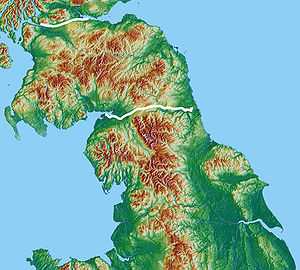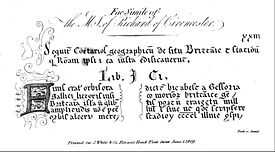Attacotti

The Attacotti (Atticoti, Attacoti, Atecotti, Atticotti, Atecutti, etc. variously spelled) were a people who despoiled Roman Britain between 364 and 368, along with Scotti, Picts, Saxons, Roman military deserters, and the indigenous Britons themselves. The marauders were defeated by Count Theodosius in 368.
Units of Attacotti are recorded about 400 AD in the Notitia Dignitatum, and one tombstone of a soldier of the Atecutti is known. Their existence as a distinct people is given additional credence by two incidental references to them, as cannibals and as having wives in common, in the writings of Saint Jerome.
Ammianus: Roman Britain in 364–369


The historian Ammianus provides an account[1] of the tumultuous situation in Britain between 364 and 369, and he describes a corrupt and treasonous administration, native British troops (the Areani) in collaboration with the barbarians, and a Roman military whose troops had deserted and joined in the general banditry. The situation arose as a consequence of the failed imperial power-grab (350-353) by Magnentius (303-353), followed by a bloody and arbitrary purge conducted by Paulus Catena in an attempt to root out potential sympathisers of Magnentius in Britain, and aggravated by the political machinations of the Roman administrator Valentinus.
Ammianus describes the marauders as bands moving from place to place in search of loot. Nevertheless, one Roman commander was killed in a pitched battle and another was taken prisoner in an ambush and killed. (See Great Conspiracy.) As there was no longer an effective military force in the province, a substantial one was sent from Gaul under Count Theodosius, who quickly and ruthlessly restored order. Theodosius then focused his efforts on the repair of political problems within the province.
Notitia Dignitatum: Roman auxilia palatina
The Notitia Dignitatum is a list of offices of the early 5th century Roman Empire, and includes the locations of the offices and the staff (including military units) assigned to them. The names of several auxilia palatina resemble that of the Attacotti who were mentioned by Ammianus, and in an 1876 publication, historian Otto Seeck assigned the name Atecotti to various spellings ("acecotti", "atecocti", "attecotti", "attcoetti", "[illegible]ti", and "arecotti") in the Notitia Dignitatum, and documented his assignments within the publication.[2] This produced four conjectural occurrences of Atecotti-related units:
- Atecotti
- Atecotti juniores Gallicani
- Atecotti Honoriani seniores
- Atecotti Honoriani juniores
The discovery of a contemporary funerary dedication to a soldier of the "unit of Atecutti" (emended from "Ategutti") at Thessalonica, in the Roman Diocese of Illyricum, supports this reconstruction,[3][4] as the Notitia Dignitatum places one Atecotti unit in that diocese.
Saint Jerome: incidental references
St. Jerome was a Christian apologist whose writings contain two incidental references to the Attacotti. His account is particularly noteworthy because he was in Roman Gaul c.365-369/70, while the Attacotti were known to be in Britain until 368 and may have entered Roman military service soon after. Thus it is credible that Jerome had seen Attacotti soldiers and had heard Roman accounts of the recent fighting in Britain.[5][6]
In his Letter LXIX. To Oceanus, he is urging a responsible attitude towards marriage, at one point saying that one should not be "like the Scots [ie, the Irish Scoti] and the Atacotti, and the people of Plato's Republic, to have community of wives and no discrimination of children, nay more, to be aware of any semblance even of matrimony".[7]
In his treatise Against Jovinianus he describes the dietary habits of several peoples and includes a statement that he had heard that the Attacotti ate human flesh.[8] Earlier in the same passage he describes a different people as eating "fat white worms with blackish heads", and others as eating "land-crocodiles" and "green lizards". Ancient writers sometimes ascribed exotic habits to far-away peoples in their works. Strabo, for example, said in passing that some Sarmatians and Scythians were cannibals, while others ate no meat at all.[9]
De Situ Britanniae: a spurious reference

De Situ Britanniae was a fictitious account[10][11] of the peoples and places of Roman Britain. It was published in 1757, after having been made available in London in 1749. Accepted as genuine for more than one hundred years, it was virtually the only source of information for northern Britain (i.e., modern Scotland) for the time period, and some historians eagerly incorporated its spurious information into their own accounts of history. The Attacotti were mentioned in De Situ Britanniae, and their homeland was specified as just north of the Firth of Clyde, near southern Loch Lomond, in the region of Dumbartonshire.[12][13]
This information was combined with legitimate historical mentions of the Attacotti to produce inaccurate histories and to make baseless conjectures. For example, Edward Gibbon combined De Situ Britanniae with St. Jerome's description of the Attacotti by musing on the possibility that a ‘race of cannibals’ had once dwelt in the neighbourhood of Glasgow.[14]
Possible Irish connection
Perhaps as early as the 17th century, and certainly in the 18th and 19th centuries, some Irish scholars (Charles O'Conor and John O'Donovan, for example) had suggested that the origin of the Attacotti might lie in Ireland. This was based on the perceived similarity between Latin Attacotti and the Old Irish term aithechthúatha, a generic designation for certain Irish population groups, usually translated "rent-paying tribes", "vassal communities" or "tributary peoples". In the context of well-attested Irish raids on the western coast of Britain in the late Roman period, it was suggested that one or more of these population groups might be the raiders reported by Ammianus in the 360s.
The thesis was given impetus when historian Charles O'Conor promoted it in the late 18th century. However, this remained controversial among scholars into the late 19th century.
Later scholarship has diminished the notability of these early arguments by criticising the possible connection between Latin Attacotti and aithechthúatha on etymological grounds. Early scholars had based their arguments on the Old Irish that was known from medieval manuscripts rather than on the largely hypothetical Primitive Irish used in the 4th century when the Attacotti were in Britain.
Knowledge and understanding of the history of the Irish language were revolutionised from the end of the 19th century, largely owing to the efforts of Rudolf Thurneysen (1857–1940), who is considered the father of the modern discipline of philology. He hypothesised that Attacotti and aithechthúatha are unconnected, and that the Primitive Irish equivalent to aithechthúatha would be *Ateûiācotōtās. This, in his opinion, is too far removed from the Latin form Attacotti in Ammianus. More recent research has shown that some of the Irish population groups involved in the raiding and settlement of Roman and/or sub-Roman Britain could be classified as aithechthúatha,[17] though problems of chronology and identification persist.
References
- ↑ Yonge 1894:413,453–455,483–485 Ammianus 26.4.5 Trans., Ammianus 27.8 Trans., Ammianus 28.3 Trans.
- ↑ Seeck 1876:28–29,118,136 Notitia Dignitatum
- ↑ Feissel 1983:173–4, no. 205
- ↑ Rance 2001:247–8
- ↑ Freeman 2001:99–100
- ↑ Rance 2001:245–6
- ↑ Schaff 1893:143 Jer. Ep. 69.3 ad Oceanum. Trans.
- ↑ Schaff 1893:393–94 Jer. Adv. Jovin. 2.7. Trans., "Why should I speak of other nations when I myself, a youth on a visit to Gaul, heard that the Atticoti, a British tribe, eat human flesh, and that although they find herds of swine, and droves of large or small cattle in the woods, it is their custom to cut off the buttocks of the shepherds and the breasts of their women, and to regard them as the greatest delicacies?"
- ↑ Strabo (c. AD 20), "Bk VII, Chap III, Para 8", in Hamilton, H. C.; Falconer, M. A., The Geography of Strabo I, London: George Bell & Sons (published 1892), p. 464 Check date values in:
|date=(help) - ↑ Sylvanus Urban (Oct 1846), "Mr. Wex's dissertation on Richard of Cirencester", The Gentleman's Magazine, New XXVI, London: John Bowyer Nichols and Son (published 1846), pp. 365–369. Wex debunked the authenticity of De Situ Britanniae by showing, for example, that it contained manuscript material introduced in the 15th century, and so could not have been written in the 14th century, as the document's actual author had alleged.
- ↑ Mayor, John E. B., ed. (1869), "Editions of Ricardi Corinensis de Situ Britanniae", Speculum Historiale de Gestis Regum Angliae II, London: Longmans, Green, and Co, pp. xvii – clxiv. Mayor was researching the historical Richard of Cirencester who was falsely alleged to have written De Situ Britanniae, and wrote this detailed condemnation of the fraud.
- ↑ Bertram 1757:59–60 (English)
- ↑ Bertram 1757:44 (Latin)
- ↑ Gibbon, Edward (1788), The History of the Decline and Fall of the Roman Empire IV (New ed.), London: A. Strahan and T. Cadell (published 1838), p. 283, "If, in the neighbourhood of the commercial and literary town of Glasgow, a race of cannibals has really existed, ..."
- ↑ O'Conor, Charles (1783), "Second Letter to Colonel Vallancey, on the Heathen State, and Antient Topography of Ireland", Collectanea de Rebus Hibernicis (by Charles Vallancey) III, Dublin: Luke White (published 1786), p. 668
- ↑ O'Donovan, John, ed. (1844), The Genealogies, Tribes, and Customs of Hy-Fiachrach, commonly called O'Dowda's Country, Dublin: The Irish Archaeological Society, p. 157, in the footnotes.
- ↑ Rance 2001
Bibliography
- Bertram, Charles (1757), Hatcher, Henry, ed., The Description of Britain, Translated from Richard of Cirencester, London: J. White and Co (published 1809)
- Feissel, Denis (1983), Recueil des Inscriptions Chrétiennes de Macédoine du IIIe au VIe Siècle, Paris
- Freeman, Philip (2001), Ireland and the Classical World, Austin: University of Texas Press
- Rance, Philip (2001), "Attacotti, Déisi and Magnus Maximus: the Case for Irish Federates in Late Roman Britain", Britannia 32, pp. 243–270
- Schaff, Philip; Wace, Henry, eds. (1893), St. Jerome: Letters and Select Works, 2nd 6, New York: The Christian Literature Company, retrieved 2008-04-03 Missing
|last2=in Editors list (help) - Seeck, Otto, ed. (1876), Notitia Dignitatum Accedunt Notitia Urbis Constantinopolitanae et Laterculi Prouinciarum, Berolini
- Yonge, C. D., ed. (1894), The Roman History of Ammianus Marcellinus, London: George Bell & Sons
- Freeman, Philip (2002), 'Who Were the Atecotti?' in J.F. Nagy (ed.), Identifying the "Celtic" ([Celtic Studies Association of North America Yearbook 2] Dublin, 2002), 111—114.
- MacNeill, Eoin, "Early Irish Population Groups: their nomenclature, classification and chronology", in Proceedings of the Royal Irish Academy (C) 29. 1911. pp. 59–114
- Rance, Philip (2001),"Attacotti, Déisi and Magnus Maximus: the Case for Irish Federates in Late Roman Britain", Britannia 32: 243—270.
- Scharf, Ralf (1995), 'Aufrüstung und Truppenbenennung unter Stilicho: Das Beispiel der Atecotti-Truppen', Tyche 10: 161—178.
| ||||||||||||||||||||||||||||||||||||||||||